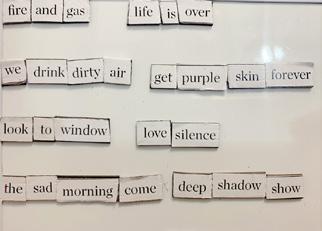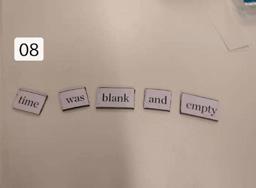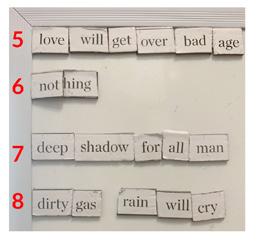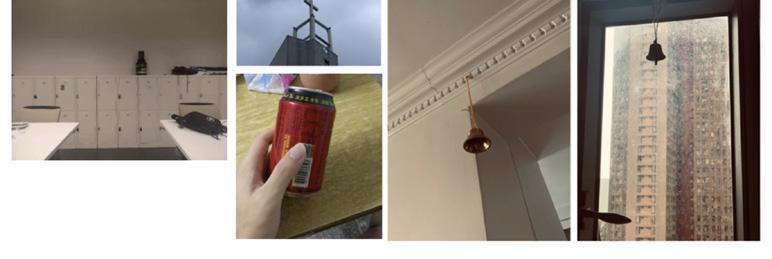
10 minute read
Cultural Probes
by 木子蘋
Summary
The cultural probes are designerly research methods used to provoke and generate ideas and inspiration about the study at hand. For this study, we wanted to know the factors that lead to social isolation, how people cope with feeling isolated and the severity of this problem among adults. The probes were designed to tap into our participants’ creative and reflective sensibilities to gently and subtly inquire about their most isolated moments, how they verbalized their feelings, the representations they made of their virtual selves, and the interactions they make with other people. They were distributed on September 30, 2019, and collected on October 9, 2019, left with the participants for a total of 8-9 days.
Advertisement
Participants:
Our participants were adults aged 23-31, many of them are foreign, postgraduate students. One of our participants is a local Hong Kong citizen. These are adults navigating new lives and recent socio-political events in Hong Kong. They are also frequent internet users.
Figure 1
Participants’ genders and age
Participant 1 is a 29-year-old German student who is in a long-distance relationship with his girlfriend in Shenzen. He is curious, introverted, but driven to succeed. He takes photographs as a hobby and he makes it a habit to capture interesting moments he encounters in Hong Kong, from everyday moments to scenes of protest and interesting buildings. Participant 2 is a 31-year-old female Hong Kong local who has been working for several years before studying again as a postgraduate student. She is a socially-conscious woman who is opinionated and helpful to anyone, including strangers. These days she experiences a lot of stress due to her school work, as well as the tense social situation in Hong Kong. Participant 3 is a 23 year old female postgraduate student from mainland China. She is sensitive, talkative, and friendly. She is interested in fashion and make-up to present herself in the best way she can. Aside from these, she is also an illustrator who likes to draw in her spare
time. Participant 4 is a 24 year old male who is a postgraduate student who studied communication. Prior to his masters study, he was the co-founder of a startup video production company. He is responsible and family-oriented. He is also fond of shooting videos
These are the questions we aimed to answers with the cultural probes:
A. What do you do on the internet everyday? B. When do you feel most lonely? Which place, what were you doing? C. What do you talk about with your friends & family? How do you contact them? D. Do you have a virtual avatar? E. How would you describe yourself offline and online?

Figures 2 & 3
Cultural Probes before being distributed to participants

Figure 4
Returned Spheres of Contact
Probe 1: Spheres of Contact
Description:
This is a set of cards and a sphere laden diagram that we asked participants to use when documenting conversations they have with other people. They would place these cards in a diagram arranged from “Very Connected” to “Very Disconnected” in spheres emanating from a center point which represents the participant’s self.

To use this probe, they would have to take one piece of the contact sheet (A) and record every time they talk to someone. The conversation can be long or short, mundane or meaningful, anything. They would also record whether it was an online conversation or a real-life talk by ticking one of the boxes at the bottom left. They will also indicate how they felt by encircling one of the faces. The next step would be to place these cards in a diagram arranged from “Very Connected” to “Very Disconnected” according to the connection level from very disconnected to very connected.
Purpose:
The main purpose of this probe is to get an insight into Question C, the friends and family they talked to, what they talked about and how they felt. We also wanted to gauge the feelings of connectedness they experienced with every conversation and see if meaningful talks could originate from all different kinds of people, friends, family, acquaintances, and strangers included.
Results:
Our participants’ returned probes reveal that distance from loved ones resulted in more connected conversations online. Conversations with family online also revealed interesting thoughts about “being an equally capable parent” or “I think it’s funny when my parents are flirting”.
Their conversations ranged from pragmatic to reflective. They had conversations for daily matters like meetings and class research, but also deeper discussions of feelings and worries about performing well, their place in the socio-political situation of Hong Kong, safety and security, and the “future”. Another interesting finding is that seemingly trivial and mundane conversations can also lead to a sense of connection for our participants.
Figure 5
Detailed Results: Spheres of Contact
Figure 6
Small Poems magnet board



Probe 2: Small Poems


Description:
This is a small magnetic board with a set of word magnets that participants can use to create small phrases that answer a certain set of prompts.
We want them to feel free to create short sentences, phrases, or even poetry (haikus, limericks) using the magnetic pieces provided and then stick them on the board provided. The words chosen was a mix of plain, functional, poetic, and descriptive words that are commonly used. We made sure to include a good mix of nouns, articles, verbs, adjectives, and prepositions. They were also given a list of prompts to follow for their short “poems”. If they wanted to, they could even make the writing prompts themselves. The writing prompts provided were:
1) Describe yourself 2) How do you feel today? 3) Are you excited about anything today? 4) What is the internet to you? 5) Tell us what you think friendship is 6) What made you happy today? 7) Thoughts about mornings 8) A weird thought you had today 9) A favorite feeling 10) A problem you are facing
Figures 7 & 8
Small Poems probe results
Purpose:
The main purpose of this probe is to get an insight into Questions A,B, and E. We wanted them to get in touch with their poetic sensibilities and materialize the words they might not be able to express when thinking from scratch. We aimed to get an insight into the descriptive feelings they might express in describing themselves and their feelings in moments of loneliness and stress.

Results:
The outcome of this probe was better than expected, we received a lot of creative interpretations of the instructions, several unexpected phrases, and also a piece of feedback regarding the words chosen for the probe. Some participants interpret the poems as graphic pieces and have a very sensorial appreciation of the feelings they experience

The most important finding was that participants were able to express their thoughts viscerally and metaphorically, instead of plainly, so they could be more interpretative about their feelings. They took the effort to be introspective and tap into emotions and thoughts that they would typically not engage in on a daily basis. There were a lot of thoughts and self-awareness about time, silence, and loneliness. An interesting observation is how our participants increased their sense of place and time with their pondering, therefore engaging a sense of physicality. This is evident with the generous use of the words “sky”, “deep”, “silence”, “shadow”, “time”, “blank”, among others.



Figure 9
Returned Real-Self profile for P2
Probe 3: Profile Builder
Description:
This is an online profile simulator similar to Instagram’s user interface that participants can customize with their own avatars, emojis, text descriptions and pictures. To use it, they would need to access the interactive Profile Builder from their laptop, phone or any other device using the QR code provided in the instructions or by accessing the URL: http://bit.ly/ probeprofilebuilder. This is a one-off probe that the participants need to do only once.

The tasks:
Enter a username Select and upload a profile picture Use only emojis to caption the profile Select 6 photos to represent their offline and online self
Purpose
This probe answers questions D and E: “How would you describe yourself offline and online?”. We intended to use this probe to get a look at how our participants would represent themselves digitally and without the pressure of a real social media profile. This is a rich probe that helped us gain insight into the images they perceived to be valuable, beautiful, and ideal.
Results
In online-self profiles, there is a desire among participants to show themselves as deep and interesting —to have an interesting personality. The photos posted are also more “high-quality”, there are also more static objects in the online-self: food, scenery, buildings, single beverages. In the real-self profiles, there are more pictures of faces, friends and family in typical settings. The photos are taken with common lighting and, in a way, are “uglier” but also more unique. The real-self profiles also featured more unique images like unfinished drawings, jewellery, stuffed toys, and blurry feet.
Profile pictures were also more stylized & idealized in the online self, while more real faces were in the real self. They were also more likely to use positive and cute emojis in the online-self, but were willing to show some cheekiness in the real-self, emojis such as these ��
Figure 10
Returned Profile Builder for all participants
Figure 11
Lonelygram from P1
Probe 4: Lonelygram

Description:
This probe asks participants to respond to a simple prompt: Take a photo whenever you feel lonely. Using any phototaking device, the participants were asked to capture anything when they felt they were lonely. The task was open to do as often as they wanted — multiple times in a day, or even just a few times a week. We reminded them via a messaging service from time to time so they would not forget the prompt and the activity. It was important for the photos to be taken as a genuine prompt spaced over a good amount of days, not crammed in a short period of time.

Purpose: The intention of this open-ended probe was to answer question B. We aimed to get an insight and visual inspiration of what our participants most observed in their surroundings while lonely. Loneliness is typically an inwardly felt emotion or feeling; with this probe, our group was curious if our participants could manifest an inward feeling, outwardly, by capturing and interpreting scenes they experienced in real life.
Figure 12
A selection of lonelygrams from all participants
Results:
The results of probe 4 revealed very compelling insights and observations. While lonely, our participants’ sense of self-awareness heightened, as mundane moments like waiting were captured a lot. Our participants also tended to identify their loneliness with singular objects (bell, single beverage cans, road signs), as if increasing their sense of comparison. This same sense of comparison is also evident in an abundance of pictures that show a juxtaposition of objects expressed through layering. They’re also able to project their feelings into solitary and steady objects like buildings and landscapes.













